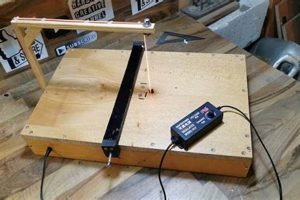A self-assembled parallel bar apparatus, frequently constructed from readily available materials, provides a stable platform for performing bodyweight exercises. Individuals utilize such equipment to execute dips, a compound movement that primarily targets the chest, shoulders, and triceps. These structures are often built within residential settings or personal training spaces to facilitate convenient access to strength training.
The construction and utilization of these personal exercise devices offer several advantages. The principal benefit lies in the cost savings compared to purchasing commercially manufactured alternatives. Furthermore, the design and dimensions can be customized to suit individual user height and space constraints. Historically, adaptable fitness solutions have been sought after to overcome financial limitations and accessibility issues related to conventional gym facilities.
The following sections will delve into the various aspects of building such an apparatus, including material selection, design considerations, construction techniques, and safety precautions to ensure a robust and dependable training aid. This exploration aims to equip individuals with the necessary knowledge to create a functional and safe exercise tool.
Tips for Building a Safe and Effective DIY Dip Bar
Constructing a durable and safe parallel bar apparatus requires careful planning and execution. The following tips are designed to guide the process and ensure a reliable piece of exercise equipment.
Tip 1: Prioritize Material Selection: Opt for robust materials, such as galvanized steel or appropriately treated lumber. Steel offers superior durability and load-bearing capacity, while treated lumber resists weather-related degradation if the apparatus is intended for outdoor use. Evaluate the weight capacity of chosen materials against anticipated usage.
Tip 2: Emphasize Structural Integrity: Securely join all components using appropriate fasteners, such as bolts, screws, or welds, depending on the materials employed. Reinforce joints with gussets or corner braces to enhance stability and prevent premature failure under stress. Precise measurements and accurate cuts are crucial for achieving a stable structure.
Tip 3: Consider Base Stability: The base of the structure must be wide and stable enough to prevent tipping during use. For portable designs, consider weighted bases or anchoring mechanisms. Permanent structures should be securely anchored to the ground or a stable foundation.
Tip 4: Ensure Proper Bar Spacing and Height: The distance between the parallel bars should be tailored to the user’s shoulder width for optimal comfort and exercise mechanics. Bar height should allow for a full range of motion during dips without excessive strain or instability. Standard spacing generally ranges from 20 to 24 inches, while height varies based on individual user dimensions.
Tip 5: Incorporate Safety Features: Round or chamfer sharp edges to prevent accidental cuts or abrasions. Apply a non-slip coating to the bars to improve grip and reduce the risk of slipping during exercise. Consider adding safety pins or locking mechanisms to adjustable designs to prevent unintended adjustments during use.
Tip 6: Conduct Thorough Testing: Before regular use, rigorously test the apparatus under controlled conditions. Gradually increase the applied load to assess its structural integrity and identify any potential weaknesses. Any signs of instability or impending failure should be addressed immediately.
Adhering to these guidelines promotes the creation of a dependable and safe parallel bar apparatus. Prioritizing material strength, structural integrity, and user safety is paramount for preventing injuries and maximizing the benefits of bodyweight training.
The subsequent sections will address advanced design considerations and maintenance procedures to further enhance the longevity and usability of the constructed apparatus.
1. Material Strength
The structural integrity and safety of a self-constructed parallel bar apparatus are directly contingent upon the material strength employed in its fabrication. The selection of materials with inadequate strength characteristics presents a clear and present danger of structural failure during use, potentially resulting in serious injury. The relationship between the chosen material and the intended load-bearing capacity is a foundational consideration. For instance, using thin-walled PVC piping, a material inherently lacking in tensile and compressive strength, to construct a parallel bar apparatus intended for an adult user would be manifestly unsuitable and prone to catastrophic failure under even moderate stress.
Conversely, utilizing appropriately sized and graded steel tubing or solid hardwood beams, each possessing significantly higher strength properties, provides a safer and more durable platform. The strength of the material directly influences the maximum weight the apparatus can safely support, and its resistance to deformation under stress. Consider the example of a parallel bar apparatus constructed from schedule 40 steel piping; its known yield strength allows for precise calculations regarding the maximum load it can bear before permanent deformation occurs. Proper material selection, therefore, allows for the safe execution of exercises by mitigating the risk of unexpected structural collapse.
In summation, material strength serves as a critical determinant of a self-constructed parallel bar apparatus’s safety and longevity. Understanding the mechanical properties of available materials and their corresponding load-bearing capabilities is essential for responsible construction and the prevention of exercise-related injuries. Failure to adequately assess and address material strength considerations constitutes a significant oversight with potentially severe consequences. The implementation of rigorous testing protocols post-construction further mitigates inherent risks associated with self-assembled equipment.
2. Joint Stability
Joint stability is a critical factor directly influencing the structural integrity and safety of a self-constructed parallel bar apparatus. The points where individual components of the device are joined together represent potential weak points where failure can occur. Insufficient joint stability can lead to catastrophic collapse during exercise, posing a significant risk of injury. The effectiveness of the parallel bar apparatus, and therefore its utility for its intended purpose, hinges on robust and reliable connections between its constituent parts.
The methods employed to achieve joint stability depend on the materials used in construction. Welded joints in steel structures, when executed properly, provide a strong and permanent bond. Bolted connections, commonly used in both steel and wooden structures, must be properly torqued and secured to prevent loosening under stress. Screwed connections, primarily used in wooden structures,
require appropriate screw size and placement to ensure adequate holding power. Regardless of the method, the joint must be capable of withstanding the forces generated during exercise, including tensile, compressive, and shear stresses. As an illustration, a wooden parallel bar apparatus with joints held together solely by small nails would likely fail under the dynamic load of a user performing dips. Conversely, properly reinforced joints using lag bolts and metal brackets would significantly enhance stability and safety.
In conclusion, joint stability is a non-negotiable requirement for a safe and functional self-constructed parallel bar apparatus. The choice of materials, connection methods, and reinforcement techniques must be carefully considered to ensure that the joints can withstand the stresses imposed during exercise. Regularly inspecting the joints for signs of loosening, cracking, or corrosion is essential for maintaining the structural integrity of the apparatus over time. A failure to prioritize joint stability undermines the entire project and places the user at unacceptable risk.
3. Base Support
The stability of a self-constructed parallel bar apparatus is fundamentally reliant on the design and execution of its base support structure. The base must provide sufficient resistance to prevent tipping, wobbling, or shifting during exercise. Inadequate base support undermines the safety and effectiveness of the entire apparatus, rendering it unusable and potentially hazardous.
- Width and Footprint
A wider base provides greater stability due to its increased resistance to overturning moments. The footprint, or area covered by the base, should be sufficiently large to distribute the load effectively. A narrow-based apparatus is prone to tipping, especially during dynamic movements. For example, an A-frame base configuration inherently offers greater stability than a single-post design.
- Weight Distribution
The base should distribute the weight of the apparatus and the user evenly across the supporting surface. Uneven weight distribution can lead to stress concentrations and premature failure. Consider adding weight plates or sandbags to the base for increased stability, particularly in portable designs. A properly weighted base resists shifting and tipping, ensuring a stable platform for exercise.
- Ground Contact and Anchoring
The points of contact between the base and the ground must be firm and stable. On uneven surfaces, adjustable feet or shims can be used to level the apparatus. For permanent installations, anchoring the base to the floor or ground provides maximum stability. Examples include bolting the base to a concrete slab or sinking it into the ground. Anchoring prevents movement and significantly reduces the risk of tipping.
- Material Selection and Construction
The materials used for the base should be strong and durable, capable of withstanding the weight and forces generated during exercise. Steel is a common choice for its strength and resistance to deformation. The base should be constructed with robust joints and connections to prevent weakening over time. Regularly inspect the base for signs of damage or wear, and make any necessary repairs promptly. A well-constructed and maintained base ensures the long-term stability of the apparatus.
These facets of base support, when properly addressed, contribute to the creation of a secure and reliable self-constructed parallel bar apparatus. Neglecting these considerations compromises the safety and usability of the device, negating the benefits of bodyweight training. Consistent monitoring and maintenance of the base are essential for preserving structural integrity and preventing potential injuries.
4. Ergonomic Dimensions
The efficacy and safety of a DIY dip bar are directly correlated with its ergonomic dimensions. Improperly sized equipment can lead to discomfort, reduced range of motion, and an increased risk of injury. The dimensions, specifically the width between the bars and the height of the bars from the ground, necessitate careful consideration during the design and construction phase. These measurements should align with the user’s anthropometry to facilitate proper biomechanics and minimize strain. For instance, a dip bar with an excessive width may force the user to overstretch, potentially leading to shoulder impingement or pectoral muscle strain. Conversely, a width that is too narrow restricts movement and compromises exercise effectiveness. Likewise, an inadequate bar height may necessitate an awkward starting position, increasing the risk of lower back pain or instability.
Practical application involves tailoring the dimensions to the individual user. A taller individual requires a higher bar height than a shorter person. Similarly, the distance between the bars should accommodate the user’s shoulder width. Adjustable designs offer a versatile solution, allowing for customization to suit multiple users with varying body sizes. However, adjustable mechanisms must be robust and secure to prevent unintended adjustments during exercise. Furthermore, consider the grip diameter of the bars. A diameter that is too large or too small can compromise grip strength and increase the risk of wrist strain. For example, standard plumbing pipe provides a commonly available and adequately sized gripping surface, while excessively thick bars found in some commercial gyms may prove unsuitable for individuals with smaller hands.
In summary, ergonomic dimensions are paramount to the safe and effective use of a DIY dip bar. Customization based on individual anthropometry minimizes the risk of injury and optimizes exercise performance. While readily available materials offer cost-effective construction, prioritizing user comfort and proper biomechanics through careful attention to dimensions is essential. The challenge lies in balancing cost-effectiveness with the need for tailored ergonomics, highlighting the importance of meticulous planning and precise execution in the DIY process.
5. Surface Finish
The surface finish applied to a self-constructed parallel bar apparatus is integral to user safety, comfort, and the longevity of the equipment. The texture and composition of the coating directly influence grip, resistance to corrosion, and overall user experience, necessitating a deliberate selection process.
- Grip Enhancement
The primary function of a suitable surface finish is to provide adequate grip. A smooth, untreated surface on metal or wood can become slippery, particularly with perspiration, leading to a loss of control and potential injury. Coatings such as textured paint, rubberized dips, or knurling on metal bars enhance friction, ensuring a secure hold during exercise. A real-world example includes applying a spray-on truck bed liner to the bars, creating a durable, non-slip surface. This minimizes the risk of slipping and facilitates more controlled movements.
- Corrosion Resistance
Metallic components of a parallel bar apparatus are susceptible to corrosion, especially when exposed to moisture or outdoor elements. A protecti
ve surface finish, such as powder coating or galvanization, creates a barrier against oxidation. Powder coating, for example, involves electrostatically applying a dry powder to the metal and then curing it with heat, resulting in a durable, corrosion-resistant layer. Galvanized steel, coated with a layer of zinc, offers similar protection. This extends the lifespan of the equipment and maintains its structural integrity, reducing the need for frequent repairs or replacements. - User Comfort
The tactile qualities of the surface finish directly impact user comfort. Rough or abrasive surfaces can cause skin irritation or discomfort during exercise. Smooth, yet grippy, finishes are preferable. Applying a layer of neoprene padding or wrapping the bars with athletic tape can enhance comfort. These modifications prevent chafing and allow for longer training sessions without discomfort, promoting consistent use of the equipment.
- Aesthetic Appeal & Maintenance
While primarily functional, the surface finish also contributes to the overall aesthetic appeal of the apparatus. A well-applied finish enhances the appearance of the equipment and reflects a commitment to quality construction. Furthermore, certain finishes are easier to clean and maintain. Powder-coated surfaces, for example, are resistant to stains and can be easily wiped down. Simplifies ongoing cleaning and maintence.
Ultimately, the choice of surface finish for a self-constructed parallel bar apparatus involves a balance between grip enhancement, corrosion resistance, user comfort, and aesthetic considerations. Prioritizing these factors ensures a safe, durable, and enjoyable training experience. The selection process should be informed by the intended use of the equipment, the environment in which it will be used, and the individual preferences of the user.
6. Weight Capacity
Weight capacity stands as a paramount consideration in the design and construction of any self-assembled parallel bar apparatus. It dictates the safe operational limits of the equipment and directly influences user safety. A miscalculation or underestimation of weight capacity can lead to structural failure, resulting in potential injury.
- Material Selection and Load Limits
The selection of materials for a parallel bar apparatus is inherently linked to its intended weight capacity. Steel possesses a significantly higher tensile strength compared to wood, thus allowing for a greater load-bearing capability. For instance, schedule 40 steel pipe has a documented yield strength that can be used to calculate the maximum safe load. In contrast, using untreated lumber for a high-intensity training apparatus presents a substantial risk due to its lower strength and susceptibility to failure under repeated stress. Therefore, the inherent properties of the chosen materials directly influence the overall weight capacity of the DIY dip bar.
- Joint Integrity and Stress Distribution
The strength of the joints within a parallel bar apparatus is crucial for distributing weight effectively. Welded joints in steel structures, when properly executed, provide superior strength compared to bolted or screwed connections. Bolted connections, if used, require appropriately sized and graded hardware to withstand shear forces. Inadequate joint integrity can lead to localized stress concentrations and subsequent failure, even if the individual materials possess sufficient strength. The design must ensure that weight is distributed evenly across all structural components to maximize the overall load-bearing capacity.
- Design Considerations and Safety Factors
The overall design of the DIY dip bar influences its weight capacity. A wider base provides greater stability and distributes weight more effectively. Reinforcements, such as gussets or cross-braces, can increase the load-bearing capacity of individual components. Furthermore, a safety factor, which is a multiplier applied to the calculated maximum load, should be incorporated into the design to account for unforeseen stresses or variations in material quality. A common safety factor is 2.0, meaning the apparatus should be designed to withstand twice the anticipated maximum load. Failing to incorporate a safety factor increases the risk of structural failure under normal usage conditions.
- Testing and Validation Procedures
Prior to regular use, a self-constructed parallel bar apparatus should undergo rigorous testing to validate its weight capacity. This involves gradually increasing the applied load to assess the structural integrity of the equipment. Visual inspection for signs of deformation, cracking, or joint separation is essential. Furthermore, consider applying static and dynamic testing methods to simulate real-world usage scenarios. Successfully passing these tests confirms the design and construction are adequate for the intended weight capacity. Lack of testing compromises the safety and overall purpose of the dip bar.
The weight capacity of a DIY dip bar is not merely a numerical specification; it is a fundamental aspect of its design and construction that directly impacts user safety. Adherence to sound engineering principles, careful material selection, robust joint construction, and thorough testing protocols are essential for creating a safe and effective training apparatus.
Frequently Asked Questions About Self-Constructed Parallel Bar Apparatuses
The following section addresses common inquiries regarding the construction and utilization of self-assembled parallel bar apparatuses, often referred to as “diy dip bar” projects. These questions aim to clarify key aspects related to safety, design, and functionality.
Question 1: What is the minimum recommended safety factor for a self-constructed parallel bar apparatus?
A safety factor of at least 2.0 is strongly recommended. This means the structure should be designed to withstand at least twice the maximum anticipated load to account for material variations, unforeseen stresses, and potential construction imperfections.
Question 2: Which materials are most suitable for building a robust and durable parallel bar apparatus?
Galvanized steel and appropriately treated lumber are generally considered suitable. Steel offers superior strength and durability, while treated lumber resists weather-related degradation if the apparatus is intended for outdoor use. The specific grade and dimensions of the chosen material should be determined based on load calculations.
Question 3: What are the key considerations for ensuring adequate base stability in a portable parallel bar apparatus?
A wide base, weighted supports, or anchoring mechanisms are essential for stability. The base should be designed to prevent tipping or wobbling during use. Adjustable feet may be necessary to accommodate uneven surfaces.
Question 4: What is the recommended spacing between the parallel bars for optimal exercise biomechanics?
The spacing should be tailored to the user’s shoulder width, typically ranging from 20 to 24 inches. This allows for a full range of motion during dips without excessive strain on the shoulders or wrists.
Question 5: How can the risk of slipping be minimized during exercise on a self-constructed parallel bar apparatus?
Applying a non-slip coating, such as textured paint or rubberized dip, to the bars is crucial. Furthermore, maintaining clean and
dry hands improves grip and reduces the risk of slipping.
Question 6: What type of maintenance is required to ensure the longevity of a self-constructed parallel bar apparatus?
Regularly inspecting the joints for signs of loosening or corrosion is essential. Tightening bolts, reapplying protective coatings, and addressing any structural damage promptly will extend the lifespan of the apparatus.
Prioritizing safety, utilizing appropriate materials, and adhering to sound construction practices are essential for building a reliable and functional self-constructed parallel bar apparatus. Regular maintenance and inspection are also critical for ensuring its continued safe operation.
The following section will explore advanced design modifications and customization options for enhanced functionality and user experience.
Conclusion
The preceding discussion elucidated critical aspects of creating a “diy dip bar,” encompassing material selection, structural considerations, ergonomic dimensions, and safety protocols. This exploration underscores the importance of meticulous planning and execution to ensure the construction of a functional and safe exercise apparatus. Each phase, from initial design to final testing, demands a thorough understanding of engineering principles and a commitment to quality craftsmanship.
As individuals consider embarking on a “diy dip bar” project, a recognition of the inherent responsibilities is crucial. Rigorous adherence to safety guidelines and a dedication to sound construction practices are paramount. The ultimate objective extends beyond mere cost savings; it encompasses the creation of a durable and reliable tool that promotes fitness without compromising user well-being. Continual assessment and diligent maintenance remain essential for the enduring utility and safety of the self-constructed apparatus.







